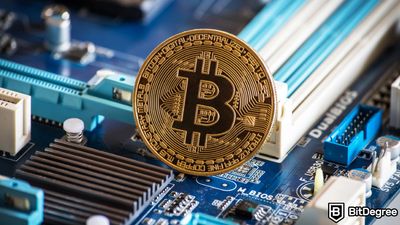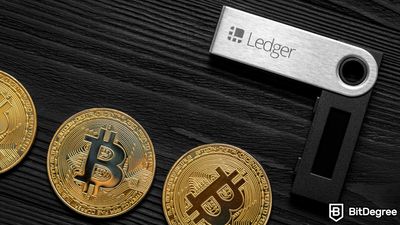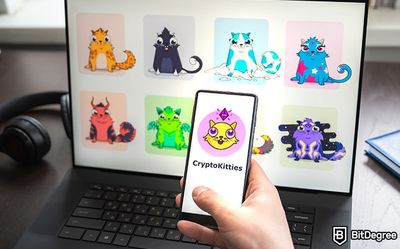Key Takeaways
- BitMart is a reasonably secure crypto exchange that gives users access to common protections like 2FA, IP address detection, and multi-signature wallet storage;
- The platform experienced a major breach in 2021 but has since added stronger protections, including a bug bounty program and better wallet infrastructure;
- You can boost your account’s safety by passing the KYC and setting up an anti-phishing code.
Stop overpaying - start transferring money with Ogvio. Sign up, invite friends & grab Rewards now! 🎁
When you store your crypto on an exchange platform, it’s a lot like leaving your valuables in someone else’s house. Naturally, you want to know if they’ve locked the doors. In BitMart’s case, the question many ask is simple: is BitMart safe?
While players like Binance, Bybit, and Kraken are known for their layered defenses, BitMart has been working to prove it belongs in the same conversation. This has become especially relevant after BitMart’s security incident in 2021, which I’ll also cover in the article.
So, is BitMart a safe exchange? Let’s discover the answer by going through its security features, risk controls, and user experience.

Did you know?
Subscribe - We publish new crypto explainer videos every week!
What is Algorand? ALGO Coin Explained With Animations


Table of Contents
- 1. Is BitMart Safe? Reviewing Its Security Features
- 1.1. Hybrid Hot and Cold Wallet
- 1.2. Multi-Signature Technology
- 1.3. Know Your Customer (KYC) Verification
- 1.4. Two-Factor Authentication
- 1.5. Anti-Phishing Code
- 1.6. Mobile App Security
- 1.7. IP Address Detection
- 1.8. Bug Bounty Program
- 2. Other Security Features
- 3. BitMart Wallet
- 4. BitMart’s 2021 Incident: What Happened Back Then
- 5. BitMart’s User Experience
- 5.1. Community Feedback
- 6. Help Center
- 7. BitMart VS Other Exchanges
- 7.1. BitMart VS Binance
- 7.2. BitMart VS Bybit
- 7.3. BitMart VS Kraken
- 8. How to Secure Your BitMart Account?
- 8.1. Enable 2FA
- 8.2. Verify Your Identity (KYC)
- 8.3. Set an Anti-Phishing Code
- 9. Conclusions
Is BitMart Safe? Reviewing Its Security Features
BitMart is a cryptocurrency exchange where you can buy, sell, and trade digital assets like Bitcoin and Ethereum. It supports hundreds of coins and operates as a custodial exchange, meaning you store your crypto on the platform while trading.
Latest Deal Active Right Now:At the time of writing, BitMart has a security rating of A and a score of 80%, making it a safe exchange.
But beyond the surface, many are still concerned with other security measures on the platform, and questions like “Is BitMart wallet safe?” get searched a lot. Let these features help convince you, or make your own judgment about the platform.
Hybrid Hot and Cold Wallet
Like most centralized exchanges (CEXs), BitMart uses a hybrid hot and cold wallet system to prevent risks and ensure operational efficiency.[1]
First, let’s quickly go through what hot and cold wallets mean. Hot wallets are connected to the internet. They’re great for fast deposits, withdrawals, and everyday trading. Cold wallets stay offline, making them much harder to hack and ideal for long-term asset storage.
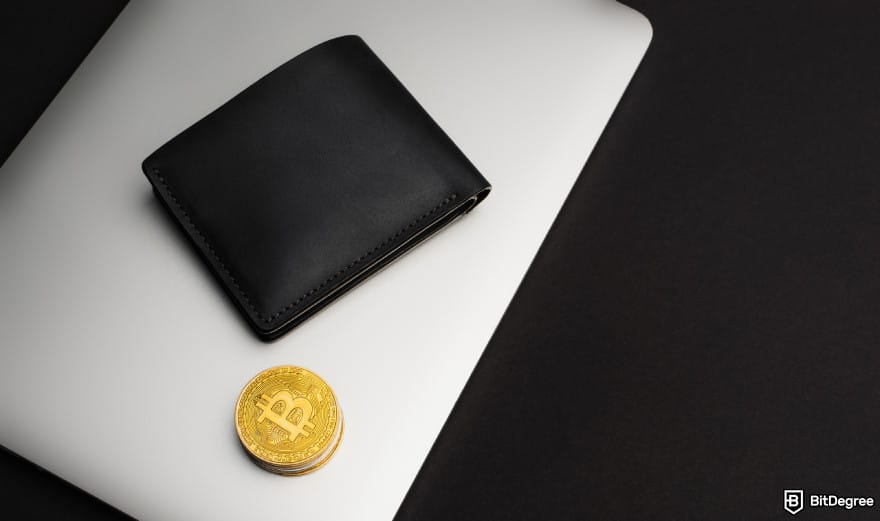
And when you combine the two, it becomes a hybrid approach. BitMart stores a large portion of user funds in cold storage on the backend while keeping just enough in hot wallets for active use. That way, you get the speed of hot wallets and the safety of cold wallets.
On the other hand, BitMart offers a custodial wallet for users to deposit their assets, fund their trades, or cash out. It’s online and controlled by the exchange. You don’t get your own private key management like you would in cold wallets like Ledger Flex.
Ledger Flex is a hardware crypto wallet designed for secure, on-the-go asset management. Check out this Ledger Flex review to learn more.
In short, BitMart wallet is safe for regular use, but it’s still not a substitute for a private cold wallet if you’re holding large amounts in the long term. I’ll cover more of this under the section about the BitMart wallet.
📚 Read More: Understanding the Different Types of Crypto Wallets
Multi-Signature Technology
BitMart also adopts the multi-signature technology. Also known as Multi-Sig, it is an extra layer of security to confirm all transactions with multiple signatures instead of one.
 Having a multi-signature wallet helps reduce the risk of unauthorized access or internal mishandling.
Having a multi-signature wallet helps reduce the risk of unauthorized access or internal mishandling.
BitMart manages their multi-sig technology through the Gnosis Safe smart contract. It’s widely used by DAOs and crypto teams for its transparency, on-chain governance capabilities, and secure fund management.
A built-in Timelock feature in the smart contract adds a delay before certain actions go through. This gives the BitMart team and the BitMart Token (BMX) DAO extra time to assess and prevent high-risk or suspicious transactions.
Know Your Customer (KYC) Verification
To comply with regulations and keep accounts secure, BitMart requires users to complete basic and advanced Know Your Customer (KYC) verifications.
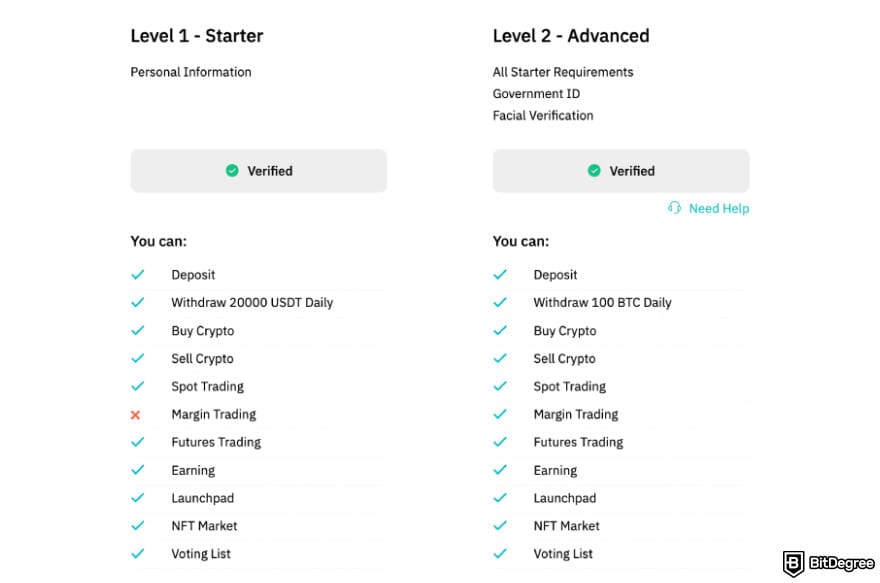
BitMart’s level 1 KYC verification allows you to access most features, except a few. These include margin trading, BitMart Earn for staking or earning interest, launchpad for early token sales, and the voting list. For the first level, here's what you need to add:
- Country (where you’re from);
- First name;
- Last name;
- Place of birth (optional);
- Date of birth.
Meanwhile, the level 2 KYC verification enables you to access all the features BitMart has to offer. Here’s what you need to provide:
- Government-issued ID (ID card or passport);
- A live selfie.
While it depends on your trading goals, completing both levels ensures your account is fully verified and ready to use without any feature limitations.
In addition to KYC, BitMart also follows the Anti-Money Laundering (AML) policy, helping make the platform more secure for users.
Two-Factor Authentication
When it comes to two-factor authentication (2FA), BitMart offers several options: mobile, email, and Google Authenticator.
For maximum security, I recommend enabling multiple 2FA options on BitMart to help block unauthorized access to your account.[2] Even if someone gets your password, they won’t get far without access to your phone or email.

Each method comes with its own pros:
- Google Authenticator is more secure than SMS or email.
- Phone (SMS) 2FA is quick and convenient, especially if you don’t want to install another app.
- Email 2FA works well as a fallback if you lose access to your phone.
Just be sure to save your backup codes in case you ever lose access to your authenticator app or device.

Did you know?
Subscribe - We publish new crypto explainer videos every week!
What Are Crypto Rollups? ZKSnarks vs Optimistic Rollups (ANIMATED)


Anti-Phishing Code
BitMart’s anti-phishing code is a simple yet powerful tool to help protect users, especially since phishing remains one of the most common problems[3] in the global community.
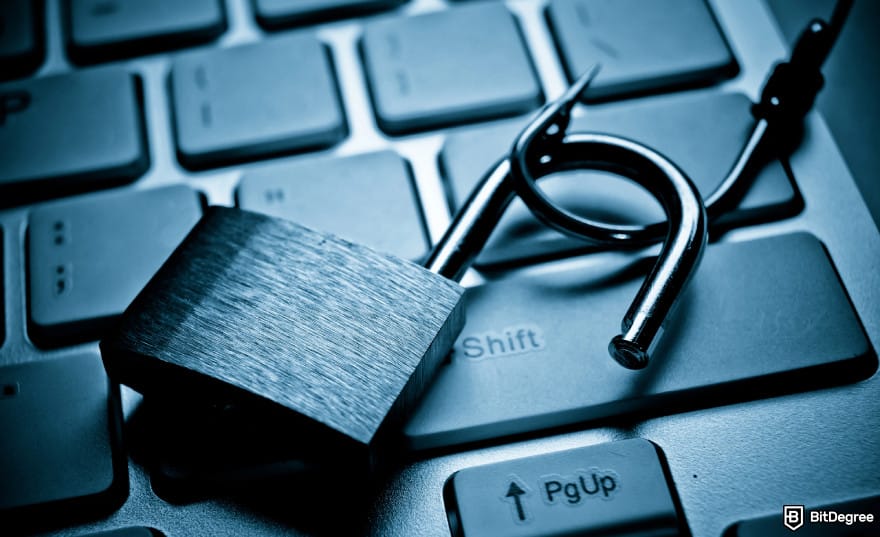
Once you set the code, this custom key gets embedded into every official email from BitMart. It helps protect you from phishing attacks by making it easy to spot fake emails pretending to be from the exchange. If the code is missing or incorrect, that’s your red flag not to click anything.
Not sure how to enable these security features? Don’t worry, I’ll walk you through how to pass KYC, turn on 2FA, and set your anti-phishing code in a while.
Mobile App Security
Is it safe to keep crypto on BitMart using the app? The answer is yes. BitMart app is safe because it offers the same level of security as the desktop version, so you’re not compromising safety when trading on mobile.
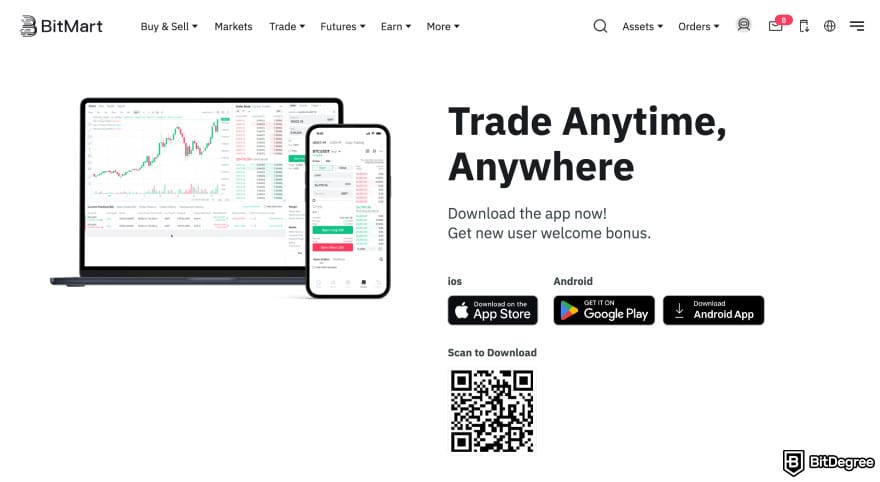
All user data is encrypted in transit, meaning your data is transferred over a secure connection. BitMart shares your user ID, app interactions, installed apps, and purchase history. If needed, you can also opt to delete your data.
When researching the mobile app’s user reviews, I found that many praise its ease of use for crypto trading, while others appreciate its security. This is similar to what the BitMart exchange review covers.
Others who left 3-star or lower ratings mention bugs, like app lag or issues with verification codes, but none raised concerns about security.
📚 Read More: Best Crypto App for Beginners
IP Address Detection
BitMart includes IP address monitoring as part of its account security. When you log in using a different IP, BitMart sends an email notification to confirm it’s you. If it’s not you, the email comes with a link to report a suspicious activity.
BitMart’s security takes it a step further when you try to connect a mobile phone using a different IP. When you want to connect a mobile phone to your BitMart account, the platform immediately sends a confirmation email with a verification code.
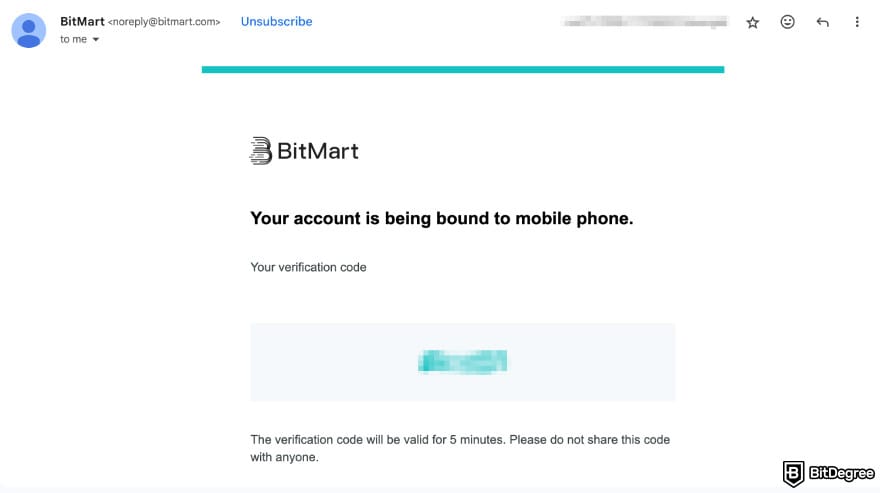
During testing, I received both types of emails: the desktop login notification and the mobile confirmation code. In both cases, the response was fast and clear. This layered approach adds an extra sense of safety and control.
Bug Bounty Program
BitMart runs a reward-based bug bounty program for ethical hackers. It’s a community-driven approach to discovering and fixing vulnerabilities before they can be exploited.
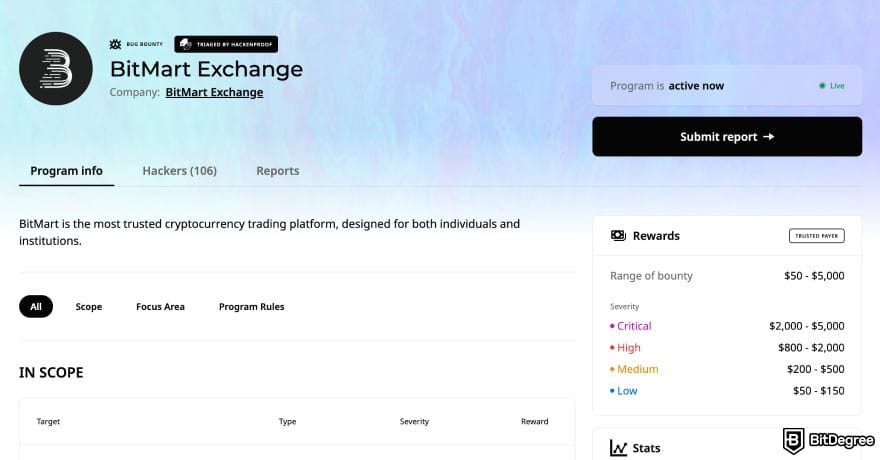
In short, if a hacker finds a valid bug and reports it responsibly, BitMart rewards them with 2,000 BitMart Tokens (BMX). It’s a win-win: the exchange patches the issue, and the researcher earns a bounty.
This program was introduced following BitMart’s 2021 security incident as part of its broader effort to enhance transparency and security. I’ll touch on this in just a moment.
BitMart also uses internal systems to maintain market stability. One example is its Auto-Deleveraging (ADL) System.
Other Security Features
To further strengthen your account and platform-level security, BitMart offers a couple of additional tools worth knowing about:
- Penetration testing. BitMart works with Hacken to run regular penetration and DDoS resistance tests, helping spot and patch security gaps before they become threats.
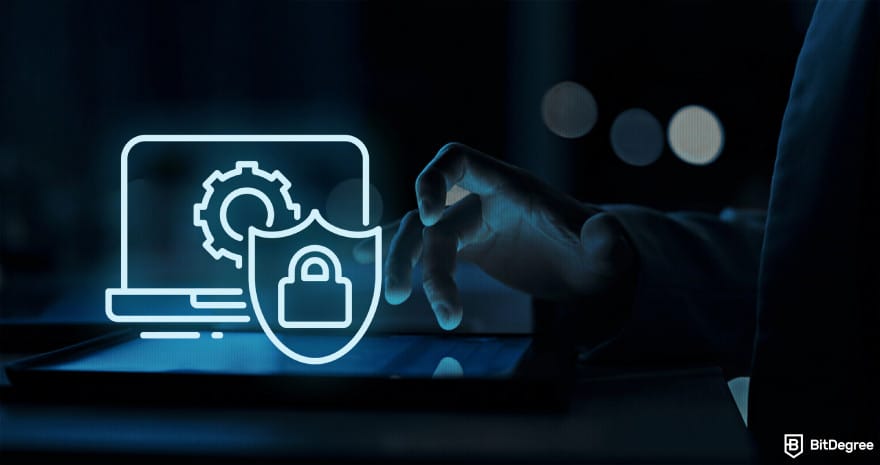
- Withdraw whitelist. You can limit withdrawals to pre-approved wallet addresses, meaning transactions can’t get through if the destination wallet isn’t on your whitelist. It’s a solid way to prevent unauthorized transfers.
Together, they give users more control and reduce the risk of common security attacks.
📚 Related Reading: Blockchain Security
BitMart Wallet
As covered earlier, BitMart’s internal wallet is a hot wallet that handles all your deposits, trades, and withdrawals. It’s fast and easy to use, but since BitMart controls the private keys, you don’t have full ownership of your crypto. That’s the trade-off with convenience.
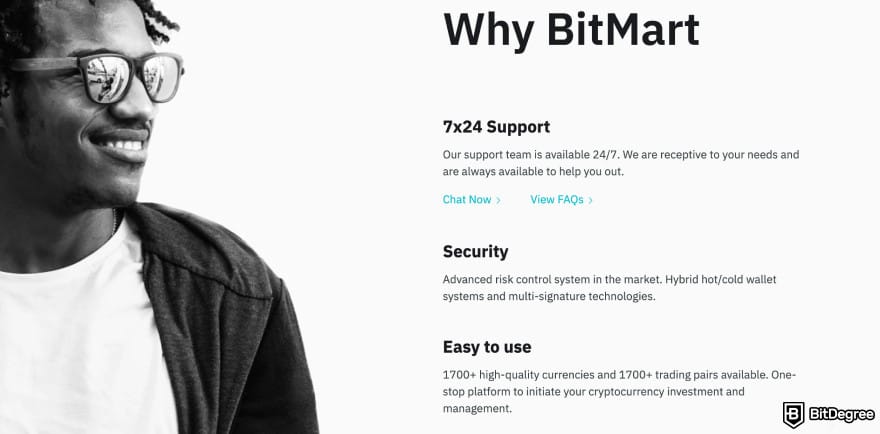
Now, let’s put that into context. Compared to personal cold wallets like Ledger Stax or Trezor Safe 5, BitMart’s wallet offers less control but more accessibility.
📚 Read More: Hot Wallet VS Cold Wallet
Cold wallets, also known as hardware wallets, give you full control and keep assets offline, which is why many long-term holders move large balances there after trading. It’s also considered a smart practice for crypto wallet security.
In short, BitMart Wallet works well for active trading and short-term use, but if you're thinking long term or want full control, pairing it with a trusted cold wallet is a smart move.
BitMart’s 2021 Incident: What Happened Back Then
When people ask is BitMart safe, the 2021 security breach might come up. It’s a fair concern, but what the platform did next matters just as much as the incident itself.
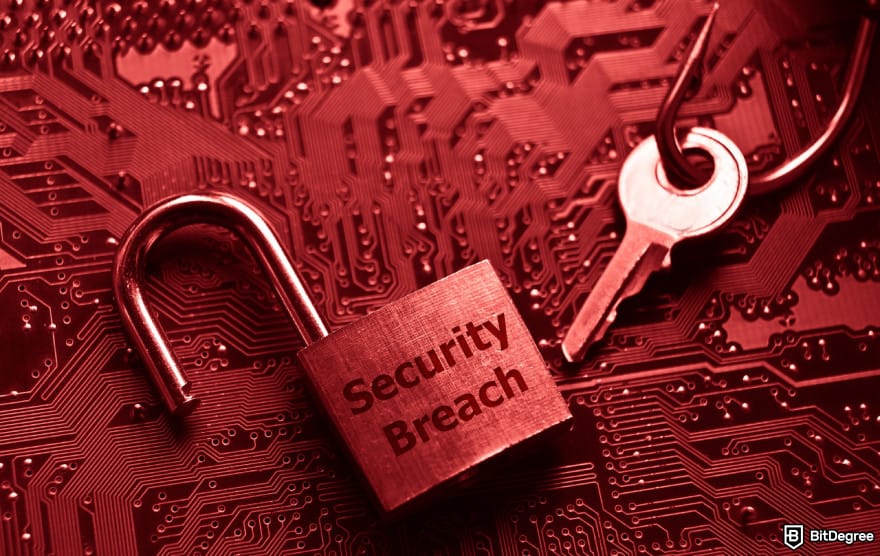 On December 4th, 2021, there was a breach caused by a stolen private key. It had access to two of BitMart’s Ethereum (ETH) and Binance Smart Chain (BSC) hot wallets. This hack was made public by PeckShield, a third-party security firm.
On December 4th, 2021, there was a breach caused by a stolen private key. It had access to two of BitMart’s Ethereum (ETH) and Binance Smart Chain (BSC) hot wallets. This hack was made public by PeckShield, a third-party security firm.
In total, BitMart lost $196 million - approximately $100 million on the Ethereum blockchain and another $96 million on the Binance Smart Chain (BSC).
During this incident, BitMart was actively resolving the issue and updated users on one of their Help Center articles.
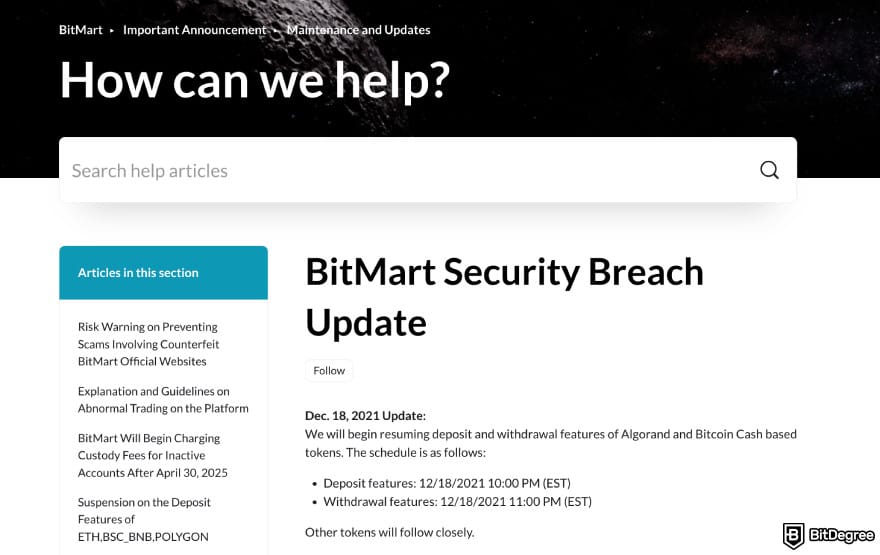
Starting two days after the incident, the exchange posted updates almost every day until the matter was resolved. They reinforced their security by December 13th, began reimbursing the users, and operations returned to normal by December 18th.
Learning from this incident, BitMart has strengthened platform-wide safety. They published a post on Medium, stating that trading has gradually resumed for Ethereum, Binance Coin (BNB), Tether, and many more.
They’ve also started the Bug Bounty program, which I mentioned earlier. This program rewards researchers and ethical hackers for reporting bugs.
All of these updates help prove that it is safe to keep crypto on BitMart. This post-incident response shows that the exchange platform took real steps to rebuild user trust.
BitMart’s User Experience
User experience is one piece of the puzzle when answering “Is BitMart safe?”. Things like how the platform handles customer issues and communicates updates can give you extra insights beyond the technical features.
Additionally, community feedback and Help Center activity help paint a clearer picture of what it’s actually like to rely on BitMart.
Community Feedback
At the time of writing, BitMart has a 3.2 rating on Trustpilot with nearly 3,000 reviews. Positive reviews highlight BitMart’s excellence in various areas, including security.
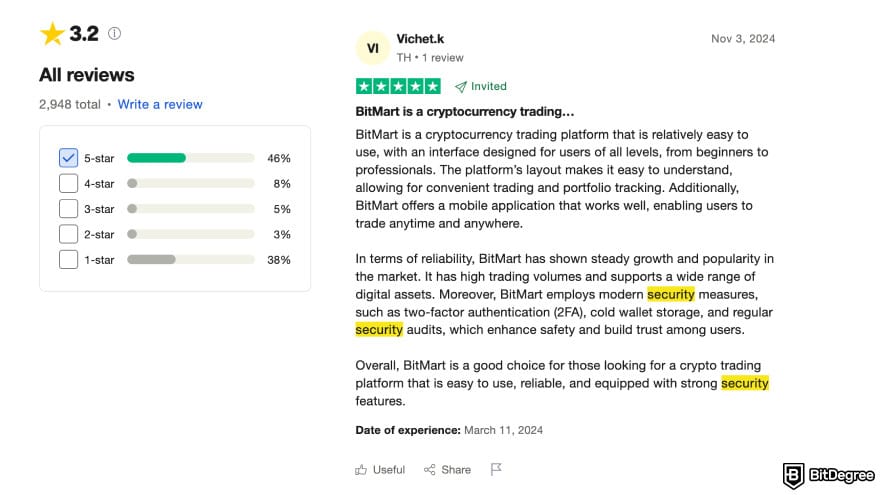
When it comes to negative feedback, some comments related to security feel vague or come from confusion about how the platform works. These tend to be one-off experiences or misunderstandings rather than signs of systemic issues.
Help Center
BitMart uses Zendesk for its official Help Center, and based on what I’ve seen, it does a solid job of keeping users informed.
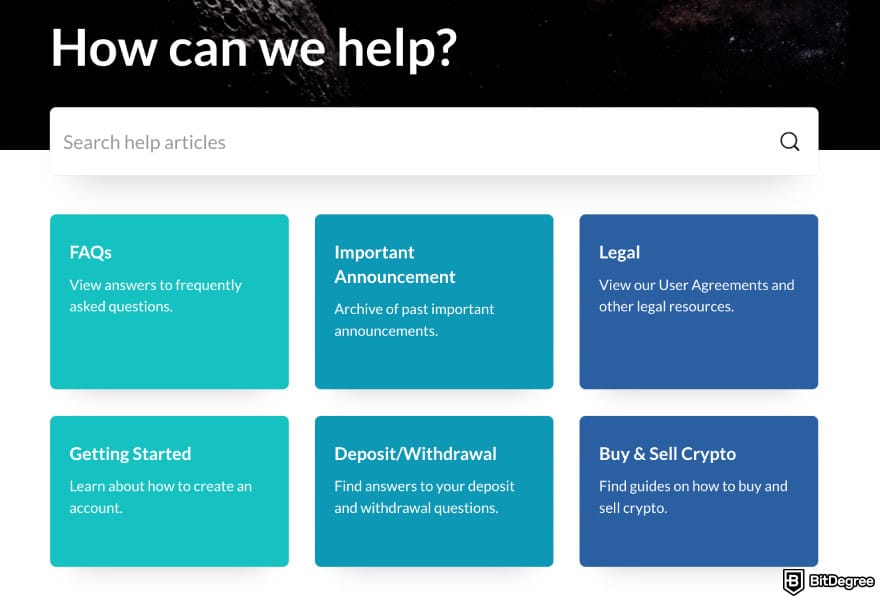
A good example of this was during the 2021 security breach. BitMart posted regular updates and outlined the steps they were taking, showing a commitment to transparency.
Whether it’s updates on features, troubleshooting, or security incidents, BitMart’s Help Center is a reliable source of official info.
BitMart VS Other Exchanges
Is BitMart safe? One way to answer that is by comparing its security features with other crypto exchanges. Below is a breakdown of how BitMart stacks up against Binance, Bybit, and Kraken.
BitMart | Binance | Bybit | Kraken | |
|---|---|---|---|---|
Cold Wallet Storage | ✓ | ✓ | ✓ | ✓ |
Multi-Signature Wallet | ✓ | ✓ | ✓ | ✓ |
Bug Bounty Program | ✓ (Flat payment for all types of bugs) | ✓ (Payment depends on severity) | ✓ (Payment depends on severity) | ✓ (Payment depends on severity) |
Penetration Testing | ✓ | ✓ | ✓ | ✓ |
KYC | ✓ (2 levels) | ✓ (3 levels) | ✓ (3 levels) | ✓ (2 levels) |
2FA | ✓ | ✓ | ✓ | ✓ |
Proof of Reserves | ✗ | ✓ | ✓ | ✓ |
Security Breaches | December 2021 | March 2018, May 2019, July 2019, November 2022 | February 2025 | No customer-level breach, but an internal bug exploited in June 2024 |
Table: Comparison of BitMart VS other exchanges
BitMart checks nearly all the standard security boxes you'd expect from a reliable cryptocurrency exchange: cold wallet storage, multi-signature wallet management, 2FA, penetration testing, and a KYC system.
While it doesn’t currently offer Proof of Reserves (PoR) like others, the core protective measures are all in place.
Proof of Reserves is a method used by crypto exchanges to show they hold enough funds to fully back customer assets.
To give you a clearer idea of how BitMart compares to others, here’s a closer look at its differences with each exchange:
BitMart VS Binance
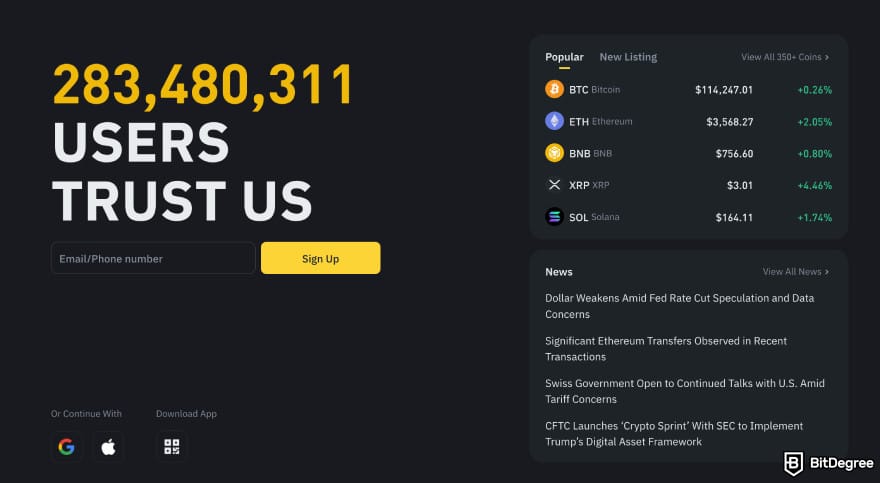 Is Bitmart a safe exchange compared to Binance? Both platforms check the boxes for standard security features, but there are some differences worth noting.
Is Bitmart a safe exchange compared to Binance? Both platforms check the boxes for standard security features, but there are some differences worth noting.
Each exchange has experienced security incidents in the past and responded by strengthening their infrastructure. BitMart’s 2021 breach led to improved wallet protections, while Binance has built a reputation for fast response and user compensation.
Notably, Binance’s Secure Asset Fund for Users (SAFU) remained untouched during past incidents, and all user assets were kept safe.
When it comes to US access, BitMart is limited but still available. Binance is not available, and while Binance US exists, it’s not the same entity as the main platform.
📚 Read More: Binance VS Binance US
Security-wise, BitMart keeps things straightforward with two KYC levels, no public Proof of Reserves, and a flat-rate bug bounty.
Binance, meanwhile, offers more advanced features, including three KYC tiers, a live PoR system, and a scalable bug bounty program that adjusts based on how severe the issue is.
BitMart VS Bybit
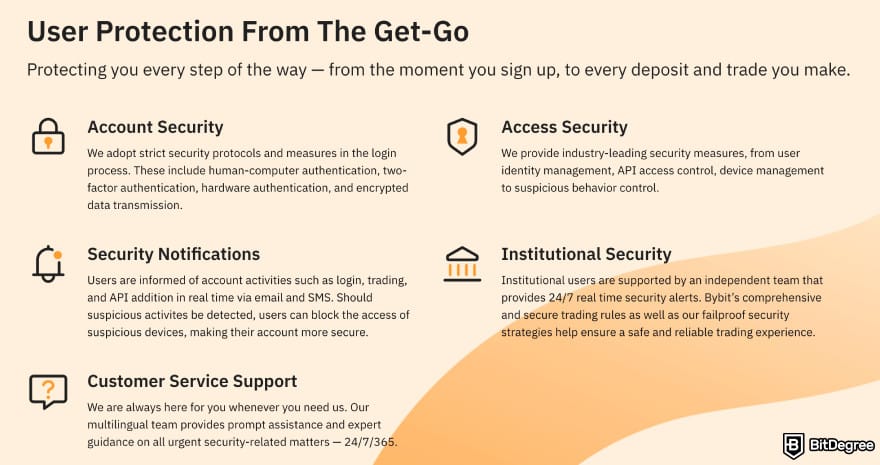 When it comes to security, Bybit leans into transparency with Proof of Reserves, three KYC levels, and a tiered bug bounty program. BitMart skips PoR and offers a flat-rate reward - a simpler option, but less flexible.
When it comes to security, Bybit leans into transparency with Proof of Reserves, three KYC levels, and a tiered bug bounty program. BitMart skips PoR and offers a flat-rate reward - a simpler option, but less flexible.
One major difference is availability. Bybit blocks US users entirely, while BitMart remains accessible in the US, even if slightly limited.
But Bybit makes up for it with a stronger regulatory footing. It’s registered in multiple jurisdictions and is actively securing licenses across Europe and the Middle East.
Both exchanges have faced security incidents. BitMart’s 2021 breach led to better wallet protections and the rollout of its bounty program. Bybit also took steps to harden its systems after its 2025 event, further reinforcing its infrastructure and internal policies.
📚 Read More: Is Bybit Safe?
BitMart VS Kraken
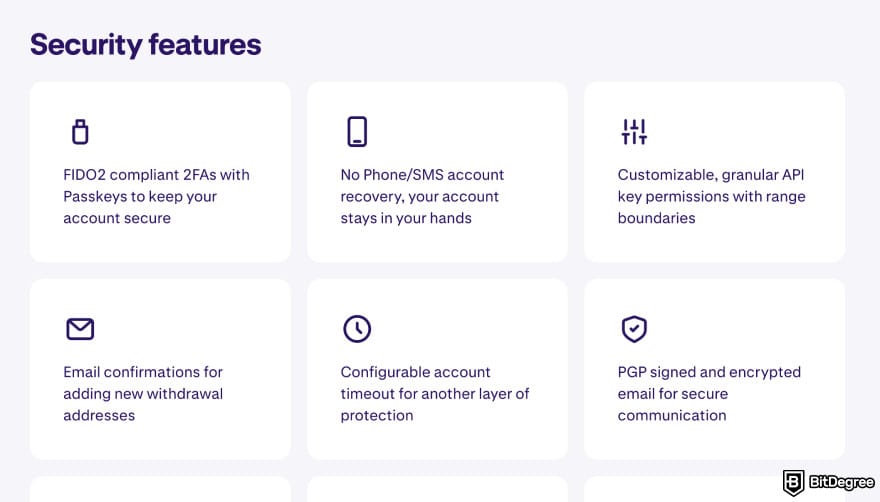
Kraken leans into heavy regulation, full US licensing, and Proof of Reserves - stuff BitMart doesn’t really offer. So, it’s fair to ask: Is BitMart safe in USA? It is available there, but it runs with less public compliance info.
📚 Read More: Best US Crypto Exchange
Security-wise, both offer bug bounty programs. Kraken’s version adjusts based on the severity of the issue, while BitMart keeps a flat-rate model.
After BitMart’s 2021 breach, it rolled out stronger wallet protections and launched its own bounty program to prevent future issues. Kraken, on the other hand, has never had a customer-level breach - only an internal bug was exploited in June 2024.
While BitMart is safe for everyday use, Kraken’s long-standing reputation and strict regulatory stance give it a clear edge in security.
Learn how to protect your crypto with security tips that go beyond just choosing a “safe” exchange. Your account's security also depends on how you protect it.
How to Secure Your BitMart Account?
To fully protect your BitMart account, make sure to set up 2FA, an anti-phishing code, and complete your KYC verification. You can do all of this under your account’s Security and Verification pages.
But first, you need to create an account on BitMart. Follow these steps to do so:
![Is BitMart safe: BitMart [Get Started] button. Is BitMart safe: BitMart [Get Started] button.](https://assets.bitdegree.org/images/is-bitmart-safe-bitmart-get-started-button.jpg)
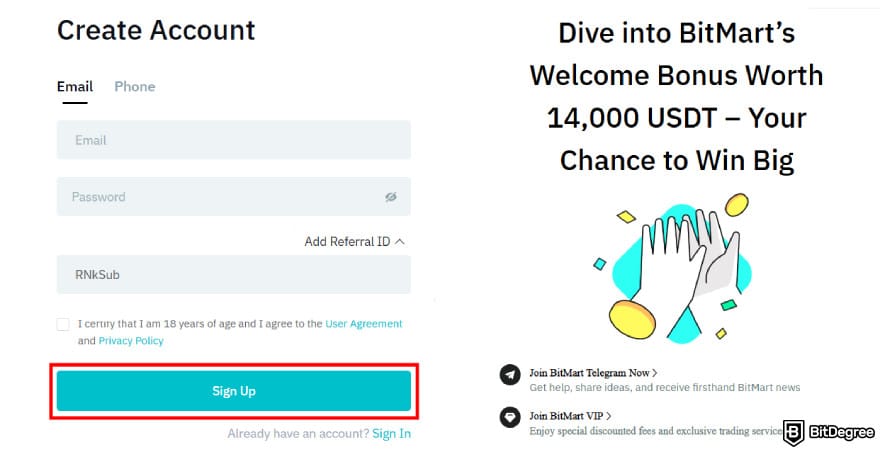
Conclusions
So, is BitMart safe? Overall, yes, it’s a relatively secure crypto exchange with features like cold wallet storage, multi-sig technology, 2FA, and regular penetration testing. The mobile app is just as secure as the desktop version.
Despite being limited, BitMart is safe in the USA as it follows key compliance standards like AML and KYC.
Furthermore, after its 2021 breach, BitMart made real improvements. It rolled out a bug bounty program and reinforced its wallet infrastructure, showing it took the incident seriously and acted on it.
When compared to other exchange platforms, BitMart holds its ground on the basics. It doesn’t necessarily lead to innovation or transparency, but it checks enough boxes for regular crypto trading.
The content published on this website is not aimed to give any kind of financial, investment, trading, or any other form of advice. BitDegree.org does not endorse or suggest you to buy, sell or hold any kind of cryptocurrency. Before making financial investment decisions, do consult your financial advisor.
Scientific References
1. Roy S.: ‘Wallet Management Practices in Cryptocurrency Exchanges: Security, Compliance, and Future Innovations’;
2. Reese K., Smith T., Dutson J., Armknecht J., Cameron J., Seamons K.: 'A Usability Study of Five Two-Factor Authentication Methods';
3. Sharma P., Dash B., Ansari M.: ‘Anti-Phishing Techniques – A Review of Cyber Defense Mechanisms’.
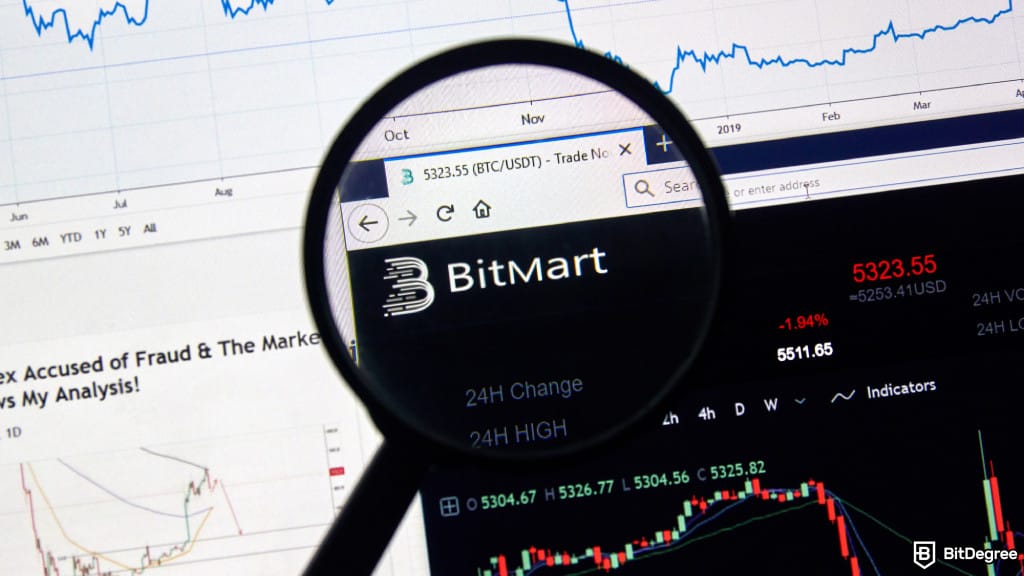

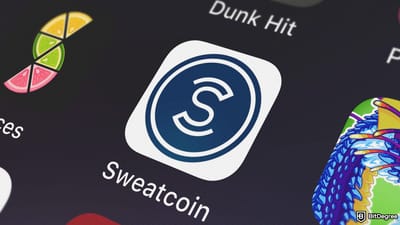
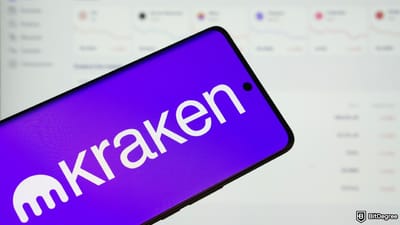
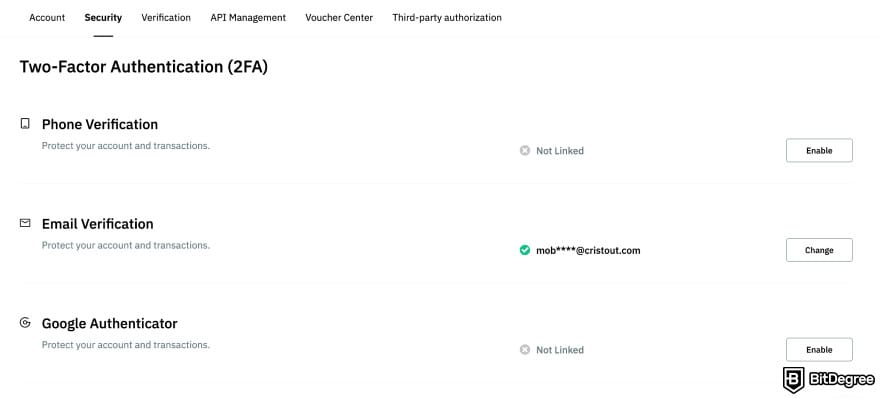
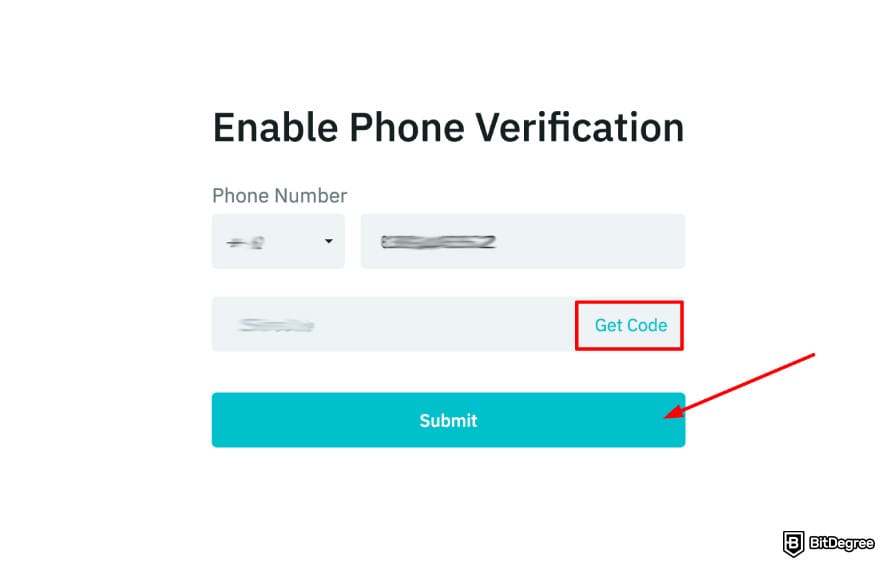
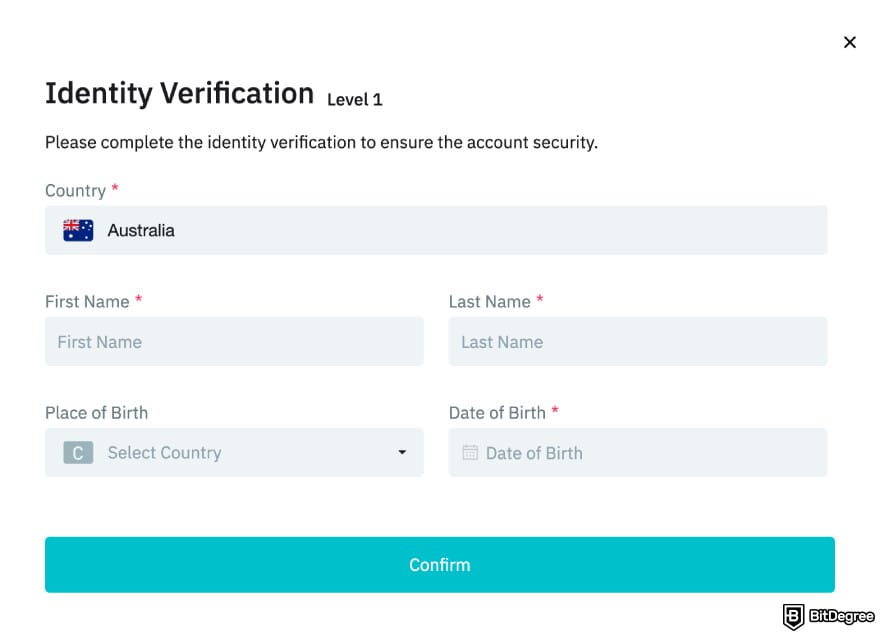
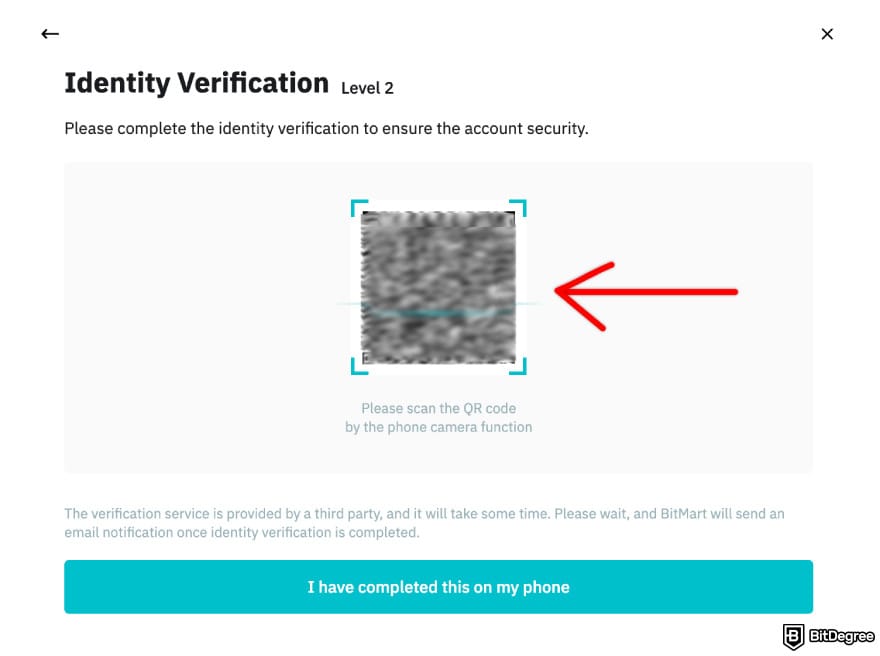
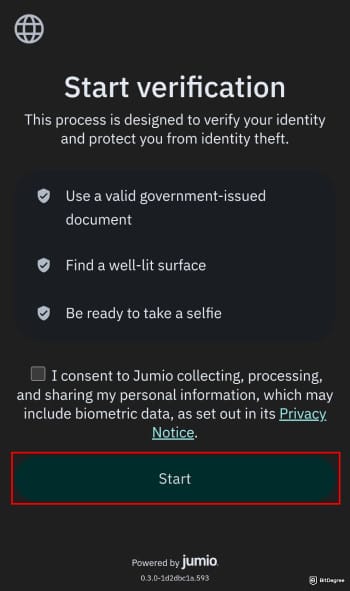
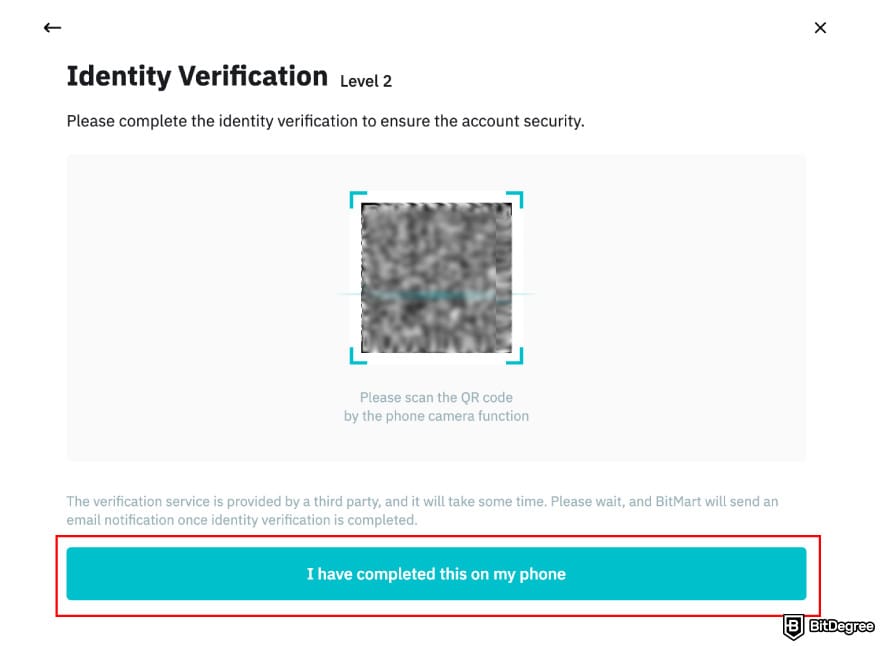 Once all verification is complete, you’ll see that your account is verified.
Once all verification is complete, you’ll see that your account is verified.


![Is BitMart safe: BitMart anti-phishing code [Set] button. Is BitMart safe: BitMart anti-phishing code [Set] button.](https://assets.bitdegree.org/images/is-bitmart-safe-bitmart-anti-phishing-code-set-button.jpg)
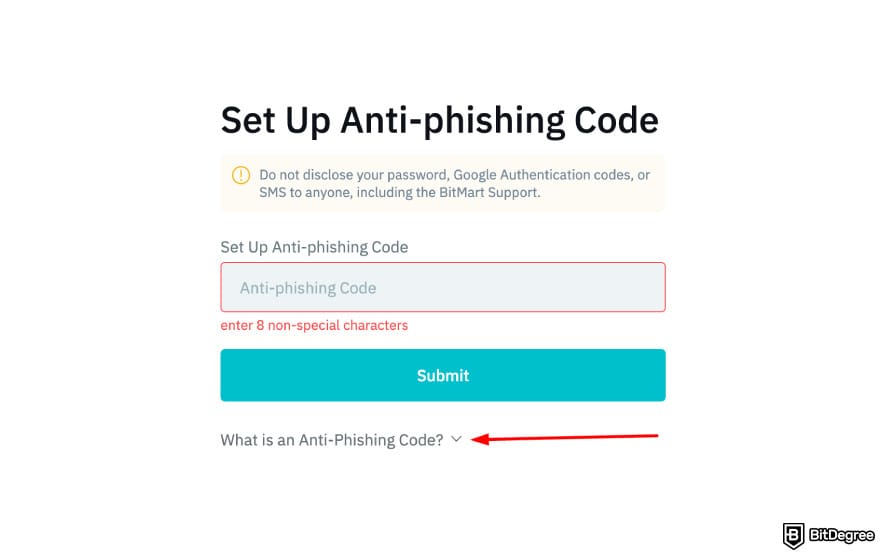
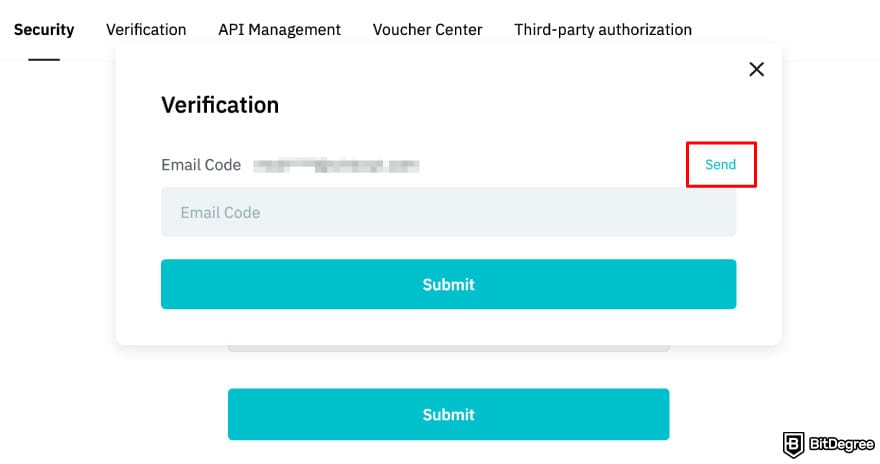
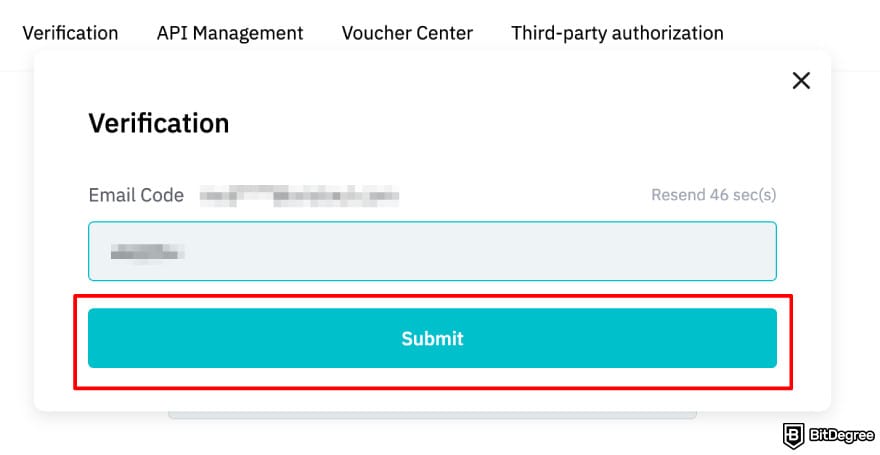
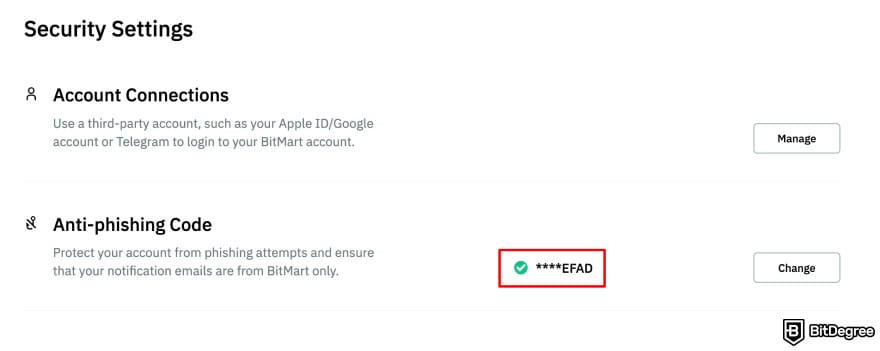 Now, every time you receive an email from BitMart, the anti-phishing code will be included. This will help you know that the email is legit and is from the platform.
Now, every time you receive an email from BitMart, the anti-phishing code will be included. This will help you know that the email is legit and is from the platform.